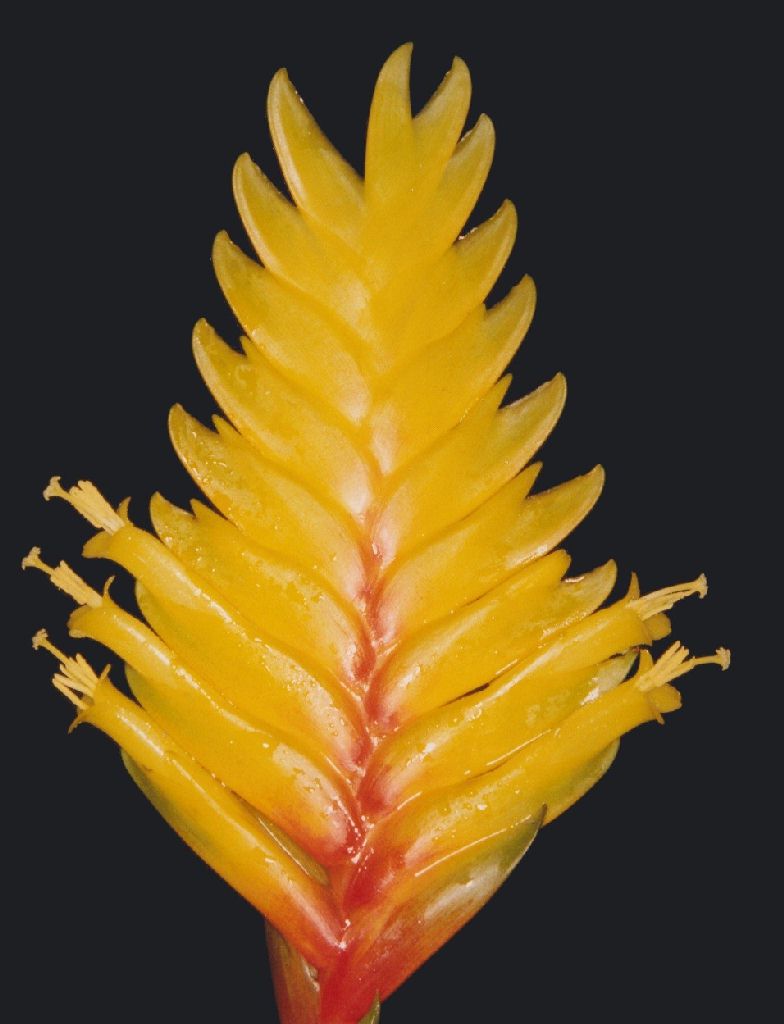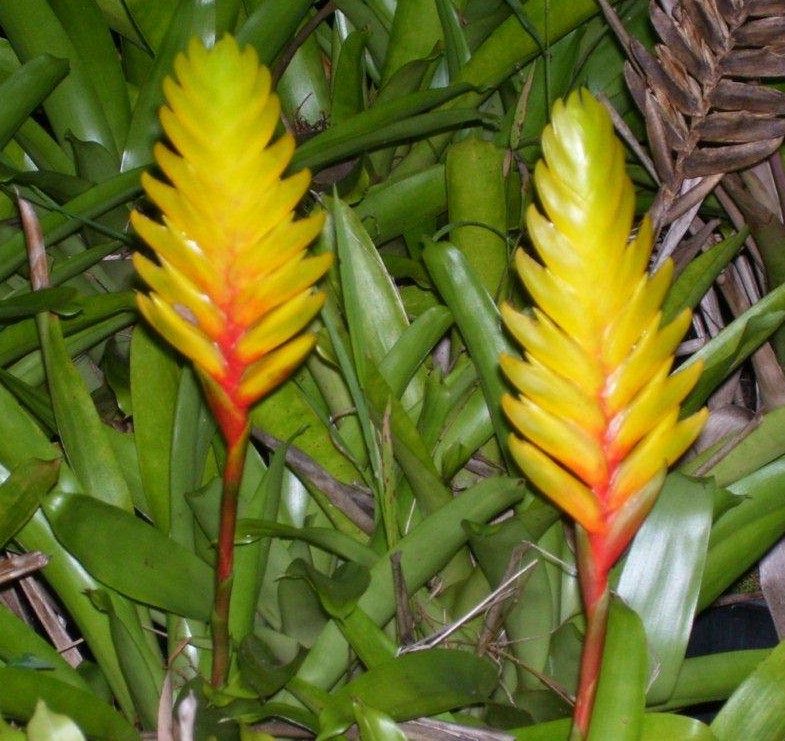

In 1995 Adelaide hosted an Australian conference and Adam Bodzioch presented a paper on Vrieseas from Belgium, that had been written by Gilbert Samyn from the Agricultural Research Centre in Ghent. Details were published in Journ. Brom Soc 45: 99-109. 1995. In the many revelations, mention was made of a Vriesea ‘Gemma’, a Duval hybrid in 1893. The problem was that his photo showed no resemblance to the ‘Gemma’ as grown in Australia. In fact our ‘Gemma’ looked like a ‘Mariae’! The description of ‘Gemma’ in the Bromeliad Cultivar Register is confusing. I quote, ‘A small plant with bright green foliage and a single upright flattened spike with yellow bracts edged in bright red – lemon yellow flowers.’ Dutrie (1946) said, “Small plant, short fat spike, bright red.”
Because I had no concrete information this apparent misidentification was put on the backburner.
In 2013 I was browsing through an old publication in DC Monogr Phaner. IX 1896 by Mez where on page 567 I found the following
Vr. Gemma Hort. Duval {Barilleti x (carinata x psittacina)} x Vr. (duvaliana x incurvata).
"Est mixture infernalis, hortulanis gaudium, botanicis horror, specie cujusque aliquid praebens. Bracteis minute punctulatis et hic Vr. Barilleti compositionis partem esse affirmatur. Inflorescentia flabellata."
Roughly translated this says – An infernal mixture, gaudy horticulturally, botanically a horror. Bracts minutely spotted as per Vr. Barilleti. Inflorescence fan shaped.
The parents of Vr. ‘Mariae’ are {brachystachys (now known as carinata) x barilleti} and you can see some similarity in the parents used, with Vr. ‘Mariae’ easier to understand. If a re-make were done it is also easier to understand it would be easier done for Vr. ‘Mariae’ rather than Vr. ‘Gemma’!
Note for the pedants amongst you. Vriesea barilleti was the spelling in those days even though you spell it Vriesea barilletii these days. If, by the way, you are growing this species please let the writer know.
We don’t know how ‘Gemma’ got to Australia other than from a record in the infamous ledger of Pinegrove nursery where it shows they got the plant in 1984 from Margaret Paterson. She in turn got her plant from Mr G. A. (Don) Patterson from Coff’s Harbour in the 1970s. Don was one of the founding members of the Australian Brom. Society and linked to ‘Beautizone’ Study group around Coff’s Harbour area. This group seems to have quietly faded away. We do not know where he obtained it, but it could have been imported by one of his contemporaries.
Further investigation has revealed that about 40 years ago Robert and Gleness Larnach were looking for bromeliads at Ferguson’s Nursery at Baulkham Hills in Sydney, and there on a round table was a Vriesea ‘Polmanii’ (Butcher’s comment – We think this is a mis-spelling of Vr. ‘Poelmanii’ in its many forms.) which lead to further enquiries. Jammed under a privet hedge was a plant called Vriesea ‘Gemma’ The assistant said that some old guy had deceased and the collection had been bought by Ferguson but no one knew what they were or what to do with them, so it was obvious that he was a collector of these imported exquisite plants very early on.
We are therefore not certain if ‘Gemma’ was imported once or on more occasions but all the action seems to be in the Central Coast area. Importation would be more likely from the USA rather than Europe and where better than a large concern in California? We know that in the 1967-8 catalogue of California Jungle Gardens there is a reference to Vriesea ‘Gemma’ described as a free flowering small edition of Vr. ‘Mariae’ on offer at US$ 2.50 Vriesea ‘Mariae’ at the same time was US$4.00, so ‘Gemma’ must have had a lower status!
In trying to find what the real differences were between Vr. ‘Mariae’ and what we grow as Vr. ‘Gemma’ I looked at the yellow petals with or without green tips and came across a problem. Vr. Mariae’ is very popular and has been widely written about. All paintings show green tips and yet the description says uniformly yellow!
Our ‘Gemma’ has totally yellow petals and I cannot find any discernible differences. I am sure that although there are plants around with “Gemma’ on the label there are some where the label got lost and the plant was subsequently identified as ‘Mariae’.
It has been suggested that this plant be called ‘Gemma Gold’ to show that it is different to the original ‘Gemma’. If you are the discerning type you may change your label but in any event the Bromeliad Cultivar Register will have both names linked in case there are queries in the future.
Acknowledgements – I would have been lost but for the findings of Ross Little.
Vriesea Gemma Gold

